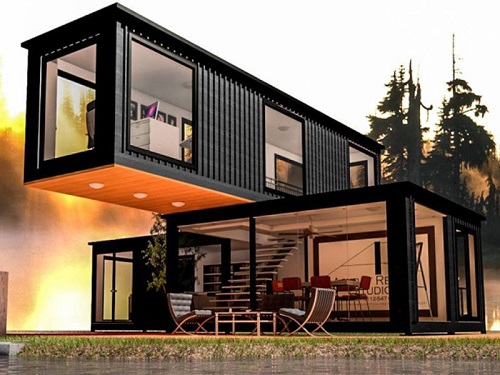In recent years, folding container houses have emerged as a revolutionary solution in the fields of modular construction, disaster relief housing, temporary accommodations, and even eco-friendly urban living. Combining the mobility of shipping containers with the flexibility of foldable engineering, these structures represent a new frontier in efficient, sustainable, and adaptive building design.
Unlike traditional prefabricated or modular homes, folding container houses can collapse for transportation, expand for use, and reassemble with minimal labor—all while maintaining durability comparable to permanent structures. Their rapid deployment and cost efficiency make them ideal for construction sites, emergency shelters, remote offices, or even long-term residential housing.
Structural Design and Engineering Principles
Core Structure
A folding container house typically uses a standardized steel frame, often based on ISO container dimensions (e.g., 20ft or 40ft lengths). However, instead of being a rigid rectangular box like a shipping container, the walls, floor, and roof are connected by hinged joints and collapsible frames.
Key structural components include:
- Main Frame: Made of high-tensile galvanized steel (Q235 or Q345 grade), providing load-bearing capacity and corrosion resistance.
- Wall Panels: Usually sandwich panels with a core of polyurethane (PU), expanded polystyrene (EPS), or rock wool, providing insulation and lightweight rigidity.
- Roof System: Designed to be foldable with built-in rain gutters and waterproof sealing gaskets to prevent leakage.
- Floor System: Often consists of steel decking with an integrated cement fiberboard or MGO (magnesium oxide) board, topped with vinyl or laminate flooring.
When folded, the house reduces to approximately one-tenth of its expanded volume, allowing easy stacking and shipping.
Folding Mechanism
The folding mechanism is the most critical technical aspect of these houses.
Common systems include:
- Hinged Wall System: Side walls are connected to the base by heavy-duty hinges, allowing them to fold inward or outward.
- Telescopic Roof System: The roof is often a single-piece or two-piece panel that folds along the centerline, aided by gas struts or hydraulic arms for stability.
- Integrated Floor and Corner Posts: When unfolded, corner posts automatically lock into place with mechanical latches or quick-connect pins, ensuring structural integrity.
The entire process of unfolding and assembly can be completed within 2–4 hours by a team of 3–4 people, without the need for heavy equipment.
Material Considerations
Steel Frame
- Material: Q235 or Q345 hot-dip galvanized steel, thickness ranging from 2.0 to 3.5 mm.
- Surface Treatment: Powder coating or galvanization to prevent rust and extend life beyond 20 years.
- Structural Strength: Capable of bearing wind loads of 0.6–0.8 kN/m² and snow loads up to 1.0 kN/m².
Wall and Roof Panels
- Sandwich Panel Thickness: Typically 50–100 mm, depending on insulation needs.
Core Options:
- EPS (Expanded Polystyrene): Economical but less fire-resistant.
- PU (Polyurethane): Excellent thermal insulation and water resistance.
- Rock Wool: Fireproof and sound-insulating, suitable for hot or industrial environments.
- Thermal Performance: U-values range between 0.2–0.4 W/m²K, depending on materials.
Flooring and Finishing
- Subfloor: Steel or aluminum structure with MGO or cement fiberboard for rigidity.
- Top Finish: Vinyl flooring, laminate panels, or wood composite for comfort and aesthetics.
- Optional Additions: Underfloor insulation, electric heating mats, or waterproof membranes.
Electrical, Plumbing, and HVAC Integration
Electrical Systems
All wiring is typically pre-installed within the wall cavities using flexible conduits.
Standard systems include:
- 110V/220V circuits depending on regional requirements.
- LED lighting with energy-efficient power management.
- External power inlet with safety breakers and internal distribution boards.
Plumbing
Folding container houses integrate PEX or PVC piping for water supply and drainage:
- Bathroom Units: Often prefabricated as compact wet-room modules.
- Water Heating: Achieved via electric or solar water heaters.
- Sewage Connection: Flexible connectors allow easy linking to external waste systems or septic tanks.
HVAC
- Ventilation: Passive airflow through adjustable vents or mechanical systems.
- Air Conditioning: Mini-split or wall-mounted AC units can be easily installed.
- Thermal Control: Insulated panels maintain comfortable indoor temperatures with minimal energy use.
Assembly and Transportation
Folding and Transport
One of the major technical advantages is the ability to transport multiple units in one container load:
- Up to 8 folded units (20ft) can fit into a single 40ft shipping container.
- Each folded unit weighs between 1.5–3.5 tons, depending on configuration.
- Lifting points and forklift pockets are built into the base frame for easy handling.
On-site Deployment
Deployment requires:
- A flat and stable foundation (concrete slab or steel beams).
- Unfolding sequence: Base → Walls → Roof → Locking & Sealing.
- Connection of utilities (power, water, sewage) via quick-connect systems.
Applications and Use Cases
- Disaster Relief Housing: Quick assembly allows emergency shelters to be deployed within hours after natural disasters.
- Military or Remote Work Camps: Easily relocatable living quarters for field operations.
- Construction Site Offices: Temporary offices with integrated HVAC, lighting, and internet connections.
- Residential Housing: Stackable or combinable units to form multi-level living spaces.
- Tourism and Hospitality: Eco-resorts or glamping pods that can be relocated seasonally.
Advantages
- Portability: Foldable design reduces transportation volume and cost.
- Speed of Installation: Rapid deployment without heavy machinery.
- Durability: Steel frame withstands harsh environments.
- Sustainability: Recyclable materials and low waste in manufacturing.
- Customization: Modular layout allows flexible design and scalability.
Technical Challenges and Future Developments
While folding container houses offer impressive versatility, several technical challenges remain:
- Waterproofing and Sealing: Ensuring long-term performance of folding joints and gaskets under repeated folding/unfolding cycles.
- Thermal Bridging: Steel frames can conduct heat; thermal breaks and advanced insulation are necessary to maintain efficiency.
- Structural Fatigue: Hinges and joints require precision engineering and periodic maintenance.
- Fire Safety: Compliance with regional fire codes requires careful material selection and certification.
- Smart Integration: Future models are exploring IoT sensors, solar panels, and battery storage for off-grid living.
Emerging innovations include hydraulic folding systems, self-locking corner mechanisms, and automated deployment for military or disaster-relief applications.
The folding container house stands at the intersection of engineering innovation, sustainability, and human adaptability. It is not merely a temporary shelter—it is a highly engineered system capable of transforming the way we think about housing mobility and efficiency.



































